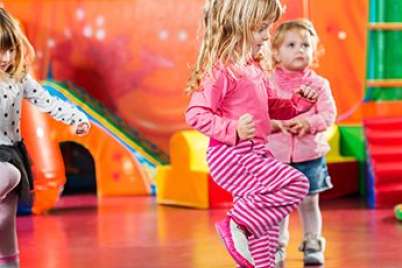
The ABCs of physical literacy
The ABCs of physical literacy refer to four basic capacities that support human movement: agility, balance, coordination, and speed. All four are essential to developing the fundamental movement skills that form the foundation of physical literacy.
Why do we need to know about the ABCs? Because it can help us as parents, caregivers, and educators to encourage children’s play that promotes these capacities and therefore physical literacy.
Agility
Agility refers to the ability to adjust our body’s physical position quickly. Perhaps more than any of the ABCs, it relies on the integration of all of them—including balance, coordination, and speed.
Physical strength and neurological reflexes are also important agility components if we’re discussing the performance of professional athletes. However, we aren’t generally looking for “professional performance” when we promote children’s agility through games such as follow the leader and hopscotch.
Balance
Balance is about maintaining your body’s centre of gravity in line with your base of support. Examples of base of support would be your feet if you’re standing, or your hands if you’re doing a handstand. If you’ve developed good balance, you should sway very little when you do any sort of balance poses.
There are two kinds of balance: static and dynamic. Static balance is when you maintain your balance in a stationary position, and dynamic balance is when you maintain your balance while you’re moving (e.g., walking, running, dancing, swinging a tennis racquet or a golf club, etc.).
To maintain balance, your body responds to a steady stream of information from all your sensory systems, including the vestibular, somatosensory, and visual systems. All these systems work together to monitor changes in your body’s spatial orientation with respect to your base of support, whether you’re maintaining static or dynamic balance.
If these systems are underdeveloped or compromised, our balance can be disrupted by changing light conditions or uneven floor and ground surfaces. Health issues such as ear infections, for example, would compromise the vestibular system.
Coordination
Coordination requires orchestrated movement of multiple parts of the body to generate actions such as walking and running. During coordinated movement, our body is constantly making adjustments to each movement according to feedback from our sensory systems, such as proprioception and vision, in a similar way to balance.
Coordinated movement is a complex process that we generally take for granted. For example, just pouring a glass of water requires a remarkably complex sequence of movements to ensure that the water travels from the pitcher into the glass and not onto the table or the floor. You need to grasp the pitcher, lift the pitcher, position the pitcher precisely above the glass, tilt the pitcher, and finally pour the water without pouring too much or missing the glass entirely.
There are different components in coordinated movement. Inter-limb coordination refers to coordination between different limbs, such as the coordinated movement of both legs when walking or running.
Intra-limb coordination refers to the movement of the different segments of a single limb, such as the coordinated movement of your upper arm, your lower arm, your wrist, and your hands to throw a ball.
Eye–hand coordination refers to how eye movements are coordinated with hand movements, such as catching a ball.
Speed
In the context of physical literacy, speed doesn’t refer to how fast you can run. It refers to how quickly you can move your body, or parts of your body, within specific movement tasks. Examples would be how fast you can move your arms when throwing, or how quickly you can jump when skipping rope. These tasks require agility, coordination, and balance, but they also require speed of muscle, limb, and body movement to perform the task efficiently and effectively.
Speed is greatly influenced by muscle strength and neurological response. It’s also affected by the proportion of fast-twitch versus slow-twitch muscle fibres in your muscles. For example, it’s generally understood that top sprinters have a higher percentage of fast-twitch muscle fibres in their legs than distance runners or slower sprinters.
How to develop the ABCs of physical literacy
The ABCs of physical literacy are best developed in childhood as they are essential to all movement skill development through childhood and adolescence. Parents, caregivers, and teachers can promote the development of the ABCs by encouraging children in unstructured active play from a young age.
Unstructured play means activities that are initiated and controlled by the children themselves. Adults may provide supervision to maintain safety and any needed support, but the play is inspired and directed by the children. A couple of examples would be making mud pies or inventing active games where the children determine the rules.
Need ideas for getting kids moving and developing their ABCs? Check out our activities page for games and activities for all ages.





